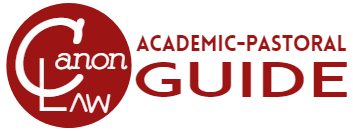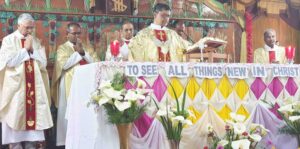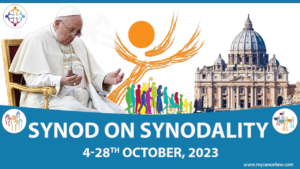What is a Religious Institute?
The Code of Canon Law 1917 defined Religious Institute as: «A Society approved by legitimate ecclesiastical authority in which the members of their own Institute, pronounce public vows, perpetual or temporary upon the elapse of time, and who tend to evangelical perfection» (can. 488, 1°). The Code of Canon Law 1983 carries over the old definition with minor changes in the following expression: «A Religious Institute is a society in which, in accordance with their own law, the members pronounce public vows and live a fraternal life in common» (can. 607 §2).
The Latin term generally used in the Old Code was «religio», although, in some instances other nomenclatures, such as institutum religiosum (Religious Institute) and familia religiosa (Religious Family) were used in its stead. The notion of religio (from religo, religare i.e., to tie; to fasten behind) is very much connected to the strict observance of religious ceremonial. Thus, in the positive sense, we can deduce that a religious is one who dedicates his/ her life to the divine worship and who has exclusive preoccupation on things that have reference to God. Before the promulgation of the Code of Canon Law 1917, religio meant strictly a religious Order. Later, the meaning of the term was extended to include «Religious Congregations».
In the Code of Canon Law 1983, the term religio or «religion» is no longer used. «Religious Institute» or simply «Institute» replaces it as a generic term referring to any Institute of Consecrated Life. By the same token, the new universal law has also abandoned most of the categories and nomenclature used in the Old legislation, especially those found in canon 488, 2°-8° CIC/1917.
1) Charismatic and Canonical foundations of a Religious Institute
The charismatic and canonical foundations are the two constitutive and complementary moments in the erection of a Religious Institute. The «Charismatic foundation» refers to the moment when the future founder or foundress, having received the inspiration from the Holy Spirit, inaugurates a new way of witnessing the Gospel – usually with an initial group of companions to respond to a particular need of the Church – with the creation of a new religious family.
The «canonical foundation» refers to the second moment when the hierarchical authority intervenes by giving its approval, confirming that indeed the new Institute is a gift of the Spirit to the same Church. This said approval is not only in the negative sense (approbationem negativum), that is, not prohibited to exist, but a positive approval that consists in the positive judgment of the foundation of the Institute.
Therefore, each Institute is rightly initiated by the charismatic founder is formally erected with the decree of approval from the competent ecclesiastical authority. It is then proper to say that there are, in fact, two founders of every religious congregation – «the charismatic founder who starts the congregation in the beginning», and the «hierarchical founder who gives the canonical approval».
2) Religious Orders and Religious Congregations
The Code of Canon Law 1917 made a distinction between Religious Orders and Religious Congregations. A «Religious Order» was an institute in which members professed solemn vows. The CIC/1917 made further distinction regarding «Regulars» and «Nuns». Men members of the Institute who professed solemn vows were called «Regulars», while the women members of the Institute were called «Nuns». In contrast, the same Code of Canon Law 1917 stated that an Institute would be called «Congregation» if its members professed simple vows. Consequently, those who professed simple vows were called «Religious» or «Sisters» (cf. can. 488, 7° CIC/1917).
In the Code of Canon Law 1983, the canons that pertain to Religious Institutes no longer make any distinction between «solemn» and «simple vows». In fact, the expression «solemn vows» is mentioned only in canon 1192 §2, just in case some Religious Institute might wish to use it in their proper law. Moreover, the term «Nuns» in the Code of Canon Law 1983 is reserved to those living in monasteries. Hence, active religious women are properly called «Sisters» instead of being called «Nuns».
3) Difference between Clerical and Lay Institute
In the Code of Canon Law 1917, the distinction between a Clerical and a Lay Institute was based simply on numerical consideration. A Clerical Religious Institute was that in which most of the members were priests, or were destined to be priests. Otherwise, it was a Lay Institute (cf. can. 488, 4° CIC/1917).
In the Code of Canon Law 1983, the difference between a Clerical and a Lay Institute is no longer based on numerical proportion of clerical-lay members. Whether an Institute will be called «Lay» or «Clerical» would solely depend on the purpose or end intended by the founder, the charism, apostolate and lawful tradition, which receive recognition from the ecclesiastical authority (cf. can. 588 §2).
4) Exempt and non-exempt Institutes
In the Code of Canon Law 1917, Religious Institutes were either «exempt» or «non-exempt». And exempt Institute referred to Religious Institute either of solemn or simple vows, that had been withdrawn from the powers of the Local Ordinaries. Exemption concerned liberty in the internal order of the Institute, such as, governance, discipline, administration, liberty in the exercise of apostolates, and the jurisdiction over the subjects. Non-exempt Institutes were just contrary.
In the Code of Canon Law 1983, there is no such significant distinction between exempt and non-exempt Institutes. Although the practice of exemption is still provided in canon 591, the traditional exempt Institutes are now under the Bishops in matters that concern the apostolate, liturgy, establishment of a house, and others, just as any other Religious Institute.
5) Institutes of Pontifical and Diocesan Rights
In the Code of Canon Law 1917, a Religious Institute of Pontifical Right was that which had received a pontifical approval (approbatio pontificia), or at least a decree of praise (decretum laudis) from the Holy See. In contrast, it was of Diocesan Right when it was erected by the Local Ordinary by virtue of a decree, and had not yet obtained a decree of praise from Rome (cf. can. 488, 3° CIC/1917).
The Code of Canon Law 1983 has kept the distinction between Pontifical and Diocesan Right in can. 589: «An Institute of consecrated life is of pontifical right if it has been established by the Apostolic See, or approved by it by means of a formal decree. An Institute is of diocesan right if it has been established by the diocesan Bishop and has not obtained a decree of approval from the Apostolic See». According to can. 579, diocesan Bishops can, by a formal decree, erect institutes of consecrated life in their own territories provided the Holy See have been consulted.




